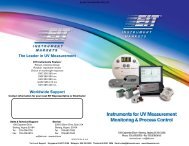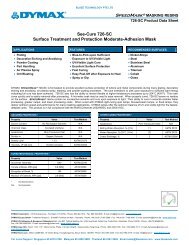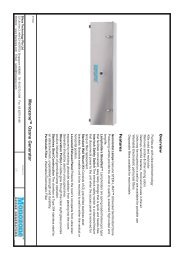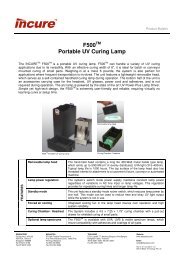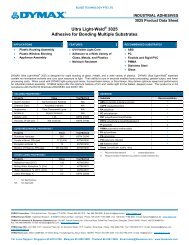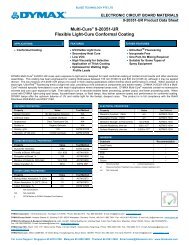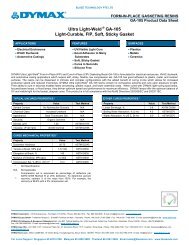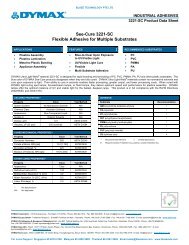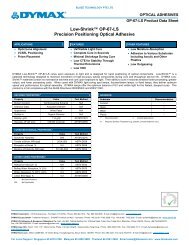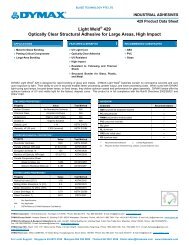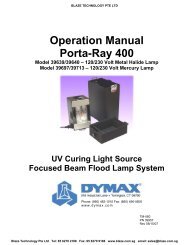1120-M-UR - Blaze Technology Pte Ltd.
1120-M-UR - Blaze Technology Pte Ltd.
1120-M-UR - Blaze Technology Pte Ltd.
Create successful ePaper yourself
Turn your PDF publications into a flip-book with our unique Google optimized e-Paper software.
BLAZE TECHNOLOGY PTE LTD<br />
MD ® MEDICAL DEVICE ADHESIVES<br />
<strong>1120</strong>-M-<strong>UR</strong> Product Data Sheet<br />
Ultra Light-Weld ® <strong>1120</strong>-M-<strong>UR</strong> Ultra-Red Fluorescing<br />
LED-Curable Plastic Bonding Adhesive<br />
APPLICATIONS<br />
FEAT<strong>UR</strong>ES<br />
RECOMMENDED<br />
SUBSTRATES<br />
BIOCOMPATIBILITY<br />
• Tube Sets<br />
• Reservoirs<br />
• Port Fittings<br />
• Drug Delivery Devices<br />
• Pumps<br />
• Curable with BlueWave ®<br />
LED Prime UVA<br />
• Tack-Free Cure Within<br />
4 Seconds<br />
• Adhesion to Wide Variety<br />
of Plastics<br />
• Moisture Resistant<br />
• Ultra-Red Fluorescing<br />
• Polycarbonate<br />
• Polyurethane<br />
• Polyamide<br />
• Polystyrene<br />
• PVC<br />
• ABS<br />
• ISO 10993 Hemolysis<br />
• ISO 10993 Cytotoxicity<br />
• ISO 10993 Implantation<br />
(14 days)<br />
• ISO10993 Intracutaneous<br />
• ISO 10993 Systemic<br />
Toxicity<br />
DYMAX MD ® Medical Device Adhesive <strong>1120</strong>-M-<strong>UR</strong> is designed for rapid bonding of a wide variety of plastics. <strong>1120</strong>-M-<strong>UR</strong> Visible/UV adhesive is<br />
formulated for fast on-demand cure with DYMAX BlueWave ® LED Prime UVA. DYMAX MD ® Medical Device adhesives contain no nonreactive solvents<br />
and cure upon exposure to light. Their ability to cure in seconds enables faster processing, greater output, and lower processing costs. When cured<br />
with DYMAX light-curing spot lamps, focused-beam lamps, or flood lamps, they deliver optimum speed and performance for medical device assembly.<br />
DYMAX lamps offer the optimum balance of UV and visible light for the fastest, deepest cures. This product is in full compliance with the RoHS<br />
Directives 2002/95/EC and 2003/11EC.<br />
UNC<strong>UR</strong>ED PROPERTIES *<br />
Property Value Test Method<br />
Solvent Content No Nonreactive Solvents N/A<br />
Chemical Class Acrylated Urethane N/A<br />
Appearance Clear to Light Yellow N/A<br />
Soluble in Organic Solvents N/A<br />
Density, g/ml 1.04 ASTM D1875<br />
Viscosity, cP (20 rpm) 300 (nominal) ASTM D1084<br />
C<strong>UR</strong>ED MECHANICAL PROPERTIES *<br />
Property Value Test Method<br />
Durometer Hardness D70 ASTM D2240<br />
Tensile at Break, MPa [psi] 19 [2,800] ASTM D638<br />
Elongation at Break, % 30 ASTM D638<br />
Modulus of Elasticity, MPa [psi] 158 [23,000] ASTM D638<br />
ADHESION<br />
Substrate<br />
Recommendation<br />
ABS acrylonitrile-butadiene-styrene<br />
<br />
CAP cellulose acetate propionate<br />
<br />
PC polycarbonate<br />
<br />
PVC poly(vinyl chloride)<br />
<br />
SAN styrene-acrylonitrile<br />
<br />
Recommended Adhesive o Limited Applications<br />
st Requires Surface Treatment (e.g. plasma, corona treatment, etc.)<br />
OTHER C<strong>UR</strong>ED PROPERTIES *<br />
Property Value Test Method<br />
Refractive Index (20˚C) 1.50 ASTM D542<br />
Boiling Water Absorption, % (2 h) 3.8 ASTM D570<br />
Water Absorption, % (25˚C, 24 h) 1.6 ASTM D570<br />
Linear Shrinkage, % 1.1 ASTM D2566<br />
Glass Transition, Tg 68.5°C DSTM 256<br />
* Not Specifications<br />
N/A<br />
Not Applicable<br />
DYMAX Corporation - 318 Industrial Lane - Torrington, CT 06790 - Phone: 860.482.1010 - Fax: 860.496.0608 - E-mail: info@dymax.com - www.dymax.com<br />
DYMAX Europe GmbH - Trakehner Strasse 3 - D-60487 Frankfurt am Main - Germany - Phone: +49 (0) 69 / 7165-3568 - Fax: +49 (0) 69 / 7165-3830 - E-mail: dymaxinfo@dymax.de - www.dymax.de<br />
DYMAX UV Adhesives & Equipment (Shenzhen) <strong>Ltd</strong> - Unit 807, Talfook Building, No. 9 Shi Hua Road, Futian Free Trade Zone, Shenzhen, China 518038 - Phone: +86.755.83485759 -<br />
Fax: +86.755.83485760 - E-mail: dymaxasia@dymax.com - www.dymax.com.cn<br />
DYMAX Asia (HK) - Unit 1006, 10/F., Carnarvon Plaza, No. 20, Carnarvon Road, T.S.T., Kowloon, Hong Kong - Phone: +852.2460.7038 - Fax: +852.2460.7017 -E-mail: dymaxasia@dymax.com -<br />
www.dymax.com.cn<br />
DYMAX Korea LLC - #903, CCMM B/D, 12 Yeoido-Dong, Youngdungpo-Gu, Seoul, Korea, 150-869 - Phone: 82-2-784-3434 - Fax: 82-2-784-5775 - E-mail: info@dymax.kr - www.dymax.co.kr<br />
For Local Support Singapore 65 6270 2188 Malaysia 60 4390 5882 Thailand 66 2361 2926 Email sales@blazeasia.com www.blazeasia.com
BLAZE TECHNOLOGY PTE LTD<br />
MD ® MEDICAL DEVICE ADHESIVES<br />
<strong>1120</strong>-M-<strong>UR</strong> Product Data Sheet<br />
C<strong>UR</strong>ING GUIDELINES (Cont.)<br />
Fixture time is defined as the time to develop a shear strength of<br />
0.1 N/mm 2 [10 psi] between glass slides. Actual cure time typically is 3 to 5<br />
times fixture time.<br />
DYMAX Curing System (Intensity)<br />
2000-EC (50 mW/cm 2 ) A<br />
5000-EC (200 mW/cm 2 ) A<br />
BlueWave ® LED Prime UVA (10 W/cm 2 ) D<br />
BlueWave ® 75 (5.0 W/cm 2 ) A<br />
BlueWave ® 200 (10 W/cm 2 ) A<br />
UVCS Conveyor with one 5000-EC (200 mW/cm 2 ) C<br />
UVCS Conveyor with Fusion F300S (2.5 W/cm 2 ) C<br />
A<br />
B<br />
C<br />
D<br />
Fixture Time or<br />
Belt Speed B<br />
1 s<br />
1 s<br />
0.2 s<br />
0.2 s<br />
0.2 s<br />
7.8 m/min<br />
[>26 ft/min]<br />
8.2 m/min<br />
[>27 ft/min]<br />
Intensity was measured over the UVA range (320-395 nm) using a<br />
DYMAX ACCU-CAL 50 Radiometer.<br />
Curing through light-blocking substrates may require longer cure times<br />
if they obstruct wavelengths used for light curing (320-450 nm for<br />
UV/Visible light curing and 320-400 nm for UV-light-only curing). These<br />
fixture times/speeds are typical for curing thin films through 100% lighttransmitting<br />
substrates.<br />
At 53 mm [2.1 in] focal distance. Maximum speed of conveyor is<br />
8.2 m/min [27 ft/min]. Intensity was measured over the UVA range<br />
(320-395 nm) using the DYMAX ACCU-CAL 100 Radiometer.<br />
Intensity was measured over the UVA/Visible range (350-450 nm)<br />
using a DYMAX ACCU-CAL 50-LED Radiometer.<br />
TACK-FREE TIME<br />
Tack-Free surface cure is the point where the surface is not able to smear.<br />
DYMAX Curing System (Intensity)<br />
Tack Free Time<br />
2000-EC (50 mW/cm 2 ) A<br />
15 sec<br />
5000-EC (200 mW/cm 2 ) A<br />
4 sec<br />
BlueWave ® LED Prime UVA (10 W/cm 2 ) D<br />
0.2 sec<br />
BlueWave ® 75 (5.0 W/cm 2 ) A<br />
0.4 sec<br />
BlueWave ® 200 (10 W/cm 2 ) A<br />
0.2 sec<br />
Time (seconds)<br />
Tack‐Free Time<br />
16<br />
14<br />
12<br />
10<br />
8<br />
6<br />
4<br />
2<br />
0<br />
1 10 100 1000 10000 100000<br />
Intensity (mW/cm2)<br />
Full cure is best determined empirically by curing at different times and<br />
intensities, and measuring the corresponding change in cured properties<br />
such as tackiness, adhesion, hardness, etc. Full cure is defined as the<br />
point at which more light exposure no longer improves cured properties.<br />
Higher intensities or longer cures (up to 5x) generally will not degrade<br />
DYMAX light-curable adhesives.<br />
DYMAX recommends that customers employ a safety factor by curing<br />
longer and/or at higher intensities than required for full cure. Although<br />
DYMAX Applications Engineering can provide technical support and assist<br />
with process development, each customer ultimately must determine and<br />
qualify the appropriate curing parameters required for their unique<br />
application.<br />
DYMAX Corporation - 318 Industrial Lane - Torrington, CT 06790 - Phone: 860.482.1010 - Fax: 860.496.0608 - E-mail: info@dymax.com - www.dymax.com<br />
DYMAX Europe GmbH - Trakehner Strasse 3 - D-60487 Frankfurt am Main - Germany - Phone: +49 (0) 69 / 7165-3568 - Fax: +49 (0) 69 / 7165-3830 - E-mail: dymaxinfo@dymax.de - www.dymax.de<br />
DYMAX UV Adhesives & Equipment (Shenzhen) <strong>Ltd</strong> - Unit 807, Talfook Building, No. 9 Shi Hua Road, Futian Free Trade Zone, Shenzhen, China 518038 - Phone: +86.755.83485759 -<br />
Fax: +86.755.83485760 - E-mail: dymaxasia@dymax.com - www.dymax.com.cn<br />
DYMAX Asia (HK) - Unit 1006, 10/F., Carnarvon Plaza, No. 20, Carnarvon Road, T.S.T., Kowloon, Hong Kong - Phone: +852.2460.7038 - Fax: +852.2460.7017 -E-mail: dymaxasia@dymax.com -<br />
www.dymax.com.cn<br />
DYMAX Korea LLC - #903, CCMM B/D, 12 Yeoido-Dong, Youngdungpo-Gu, Seoul, Korea, 150-869 - Phone: 82-2-784-3434 - Fax: 82-2-784-5775 - E-mail: info@dymax.kr - www.dymax.co.kr<br />
For Local Support Singapore 65 6270 2188 Malaysia 60 4390 5882 Thailand 66 2361 2926 Email sales@blazeasia.com www.blazeasia.com
BLAZE TECHNOLOGY PTE LTD<br />
MD ® MEDICAL DEVICE ADHESIVES<br />
<strong>1120</strong>-M-<strong>UR</strong> Product Data Sheet<br />
DEPTH OF C<strong>UR</strong>E<br />
The graphs below show the increase in depth of cure as a function of<br />
exposure time at two different lamp intensities. A 9.5 mm [0.37 in]<br />
diameter specimen was cured in a polypropylene mold and cooled to room<br />
temperature. It was then released from the mold and the cure depth was<br />
measured.<br />
3<br />
Depth of Cure<br />
BlueWave LED Prime UVA<br />
OPTIMIZING PERFORMANCE AND HANDLING<br />
1. This product cures with exposure to UV and visible light. Exposure<br />
to ambient and artificial light should be kept to a minimum before<br />
curing. Dispensing components including needles and fluid lines<br />
should be 100% light blocking, not just UV blocking.<br />
2. All bond surfaces should be clean and free from grease, mold<br />
release, or other contaminants prior to dispensing the adhesive.<br />
3. Cure speed is dependent upon many variables, including lamp<br />
intensity, distance from the light source, required depth of cure,<br />
bond gap, and percent light transmission of the substrate.<br />
Depth (mm)<br />
Depth (mm)<br />
2<br />
1<br />
0<br />
0 1 2 3<br />
6<br />
4<br />
2<br />
Time (seconds)<br />
Depth of Cure<br />
5000-EC (200 mW/cm 2 )<br />
0<br />
0 4 8 12<br />
Time (seconds)<br />
4<br />
16<br />
4. Oxygen in the atmosphere may inhibit surface cure. Surfaces<br />
exposed to air may require high-intensity (>100 mW/cm 2 ) UV light<br />
to produce a dry surface cure. Flooding the bond area with an<br />
inert gas, such as nitrogen, can also reduce the affects of oxygen<br />
inhibition.<br />
5. Parts should be allowed to cool after cure before testing and<br />
subjecting to any loads.<br />
6. In rare cases, stress cracking may occur in assembled parts.<br />
Three options may be explored to eliminate this problem. One<br />
option is to heat anneal the parts to remove molded-in stresses. A<br />
second option is to open the gap between mating parts to reduce<br />
stress caused by an interference fit. The third option is to minimize<br />
the amount of time the liquid adhesive remains in contact with the<br />
substrate(s) prior to curing.<br />
7. Light curing generally produces some heat. If necessary, cooling<br />
fans can be placed in the curing area to reduce the heating effect<br />
on components.<br />
8. At the point of curing, an air exhaust system is recommended to<br />
dissipate any heat and vapors formed during the curing process.<br />
DISPENSING THE ADHESIVE<br />
This material may be dispensed with a variety of manual and automatic<br />
applicators or other equipment as required. Questions relating to<br />
dispensing and curing systems for specific applications should be<br />
referred to DYMAX Applications Engineering.<br />
CLEAN UP<br />
Uncured material may be removed from dispensing components and<br />
parts with organic solvents. Cured material will be impervious to many<br />
solvents and difficult to remove. Clean up of cured material may require<br />
mechanical methods of removal.<br />
PERFORMANCE AFTER TEMPERAT<strong>UR</strong>E EXPOS<strong>UR</strong>E<br />
DYMAX light-curable materials typically have a lower thermal limit of<br />
-54˚C [-65˚F] and an upper limit of 150˚C [300˚F]. Many DYMAX<br />
products can withstand temperatures outside of this range for short<br />
periods of time. Please contact DYMAX Applications Engineering for<br />
assistance.<br />
DYMAX Corporation - 318 Industrial Lane - Torrington, CT 06790 - Phone: 860.482.1010 - Fax: 860.496.0608 - E-mail: info@dymax.com - www.dymax.com<br />
DYMAX Europe GmbH - Trakehner Strasse 3 - D-60487 Frankfurt am Main - Germany - Phone: +49 (0) 69 / 7165-3568 - Fax: +49 (0) 69 / 7165-3830 - E-mail: dymaxinfo@dymax.de - www.dymax.de<br />
DYMAX UV Adhesives & Equipment (Shenzhen) <strong>Ltd</strong> - Unit 807, Talfook Building, No. 9 Shi Hua Road, Futian Free Trade Zone, Shenzhen, China 518038 - Phone: +86.755.83485759 -<br />
Fax: +86.755.83485760 - E-mail: dymaxasia@dymax.com - www.dymax.com.cn<br />
DYMAX Asia (HK) - Unit 1006, 10/F., Carnarvon Plaza, No. 20, Carnarvon Road, T.S.T., Kowloon, Hong Kong - Phone: +852.2460.7038 - Fax: +852.2460.7017 -E-mail: dymaxasia@dymax.com -<br />
www.dymax.com.cn<br />
DYMAX Korea LLC - #903, CCMM B/D, 12 Yeoido-Dong, Youngdungpo-Gu, Seoul, Korea, 150-869 - Phone: 82-2-784-3434 - Fax: 82-2-784-5775 - E-mail: info@dymax.kr - www.dymax.co.kr<br />
For Local Support Singapore 65 6270 2188 Malaysia 60 4390 5882 Thailand 66 2361 2926 Email sales@blazeasia.com www.blazeasia.com
BLAZE TECHNOLOGY PTE LTD<br />
MD ® MEDICAL DEVICE ADHESIVES<br />
<strong>1120</strong>-M-<strong>UR</strong> Product Data Sheet<br />
BIOCOMPATIBILITY<br />
Polymerized DYMAX MD ® Medical Device adhesives are<br />
biocompatibility tested in accordance with ISO 10993 and/or USP Class<br />
VI. The completed tests are listed on each product data sheet. Copies<br />
of the test reports are available upon request. In all cases, it is the<br />
user’s responsibility to determine and validate the suitability of these<br />
adhesives in the intended medical device. These adhesives have not<br />
been tested for prolonged or permanent implantation, and are only<br />
intended for use in short-term (




